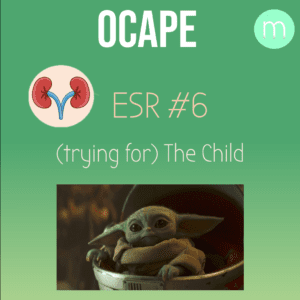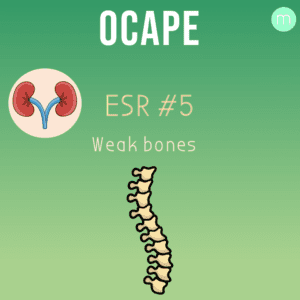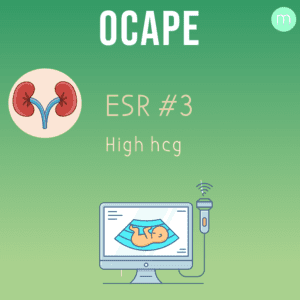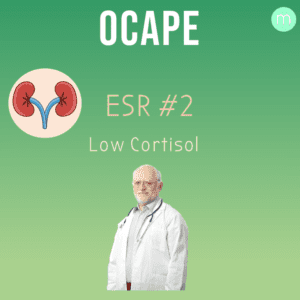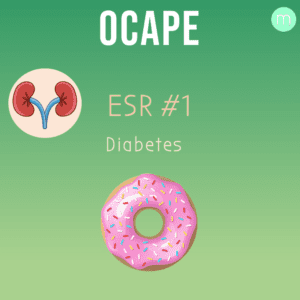 OCaPE: ESR #4
OCaPE: ESR #4
Thirst, fatigue, polyuria
You are a second year medical student at a GP placement.
A patient complains of excessive thirst, fatigue, and polyuria. He also has a headache. You measure his Blood Pressure, which is 170/95.
5 minutes
Q1)
What further tests would you do to aid your diagnosis?
Blood Na+/ K+ (electrolytes)
Blood pH
Aldosterone
Cortisol/ cortisone (2)
His blood Na+ is 230mmol/L and aldosterone levels are low.
What do you suspect is the cause?
- Apparent Mineralocorticoid Excess (1)
Explain the pathogenesis of this disease.
- Autosomal recessive mutation
- 11B-HSD (type 2) enzyme is non-functional
- Inhibits cortisol to cortisone conversion
- Excessive activation of mineralocorticoid receptor
- Due to non-specificity (3)
What treatment would you consider giving the patient?
Explain its action
- Spironolactone
- Aldosterone antagonist
- Decreases ENaC expression (less Na+ reabsorption)
- Reduces blood pressure (3)
You re-read the patient’s notes and realise that he was diagnosed with Cushing’s Syndrome a year prior to his presentation with AME.
Explain how Cushing’s Syndrome can lead to AME.
Excess cortisol
Exceeds capacity of 11B-HSD type 2 (2)
Name three other complications associated with Cushing’s Syndrome.
Hyperglycaemia, osteoporosis, immunodeficiency, hypertension, redistribution of adipose (moon-face, buffalo hump, abdominal adiposity), weight gain, insomnia, insulin resistance, mood swings, muscle weakness, menstrual disorders (3)
When things go wrong in healthcare it is important to be open and honest with patients.
What is this called?
How would you communicate this with a patient in practice?
Duty of Candour (1)
Tell the patient when something has gone wrong
Apologise to the patient
Offer appropriate remedy or support
Explain fully the short- and long-term effects of what has happened
Record details of the apology in patient’s record, (2)
Aldosterone and Cortisol are steroid hormones. Describe their receptor type and how it is activated when bound to its hormone.
Nuclear receptor
In nucleus
Inactive = covered in heat shock proteins
Ligand binding = dissociation of heat shock proteins
Activated = transactivation (of gene transcription) (+ transcription of some
genes) (3)
Key Concepts for this station:
Apparent Mineralocorticoid Excess:
• (It looks like there is too much mineralocorticoid being made, but it is due to
cortisol)
o Cortisol can bind to mineralocorticoid receptors (MRs) with higher
affinity than the glucocorticoid receptors.
o This would lead to all the cortisol binding to the MRs, activating the
receptors constantly. (This is bad)
o The enzyme 11B-HSD (11 Beta Hydroxysteroid Dehydrogenase) type 2
converts cortisol to cortisone (cortisone can’t bind to MRs) (11B-HSD
type 1 converts cortisone to cortisol, for when cortisol is needed)
o This allows the correct amount of mineralocorticoid (such as
aldosterone) to bind.
o The Problem: (Pathology)
▪ Recessive mutations (usually confined to consanguineous
parentage) can cause a defect in 11B-HSD type 2, so high cortisol
remains, activating MRs.
▪ Excess activation of the MRs appears like there is excess
mineralocorticoids. This appears as raised sodium and low
potassium in the blood.
• (This is because under normal conditions, aldosterone acts
in the collecting duct Principal cells to promote more
sodium reabsorption and more potassium excretion- via
ENaC and ROMK)
▪ Treating with an aldosterone antagonist (spironolactone) inhibits
the activation of aldosterone receptors, so less transcription of
ENaC and ROMK. (Correcting the electrolyte imbalance and
restoring blood pressure)
• Increased cortisol for the mother goes to the foetus, which then is smaller in
size (intrauterine growth retardation)
